|
DOUGIE and Batu arrived in the big wooden log cabin dining hall to join me for dinner. We took our seats at one of the solid wooden tables and almost immediately were served an enormous plate piled high in Mongolian fashion with pasta noodles and beef, all local I’m sure. It was very nice, and very filling washed down with warm yak milk. So much for my usual strategy of losing weight when I travel. Northern Asia is not the place to go on a slimming diet.
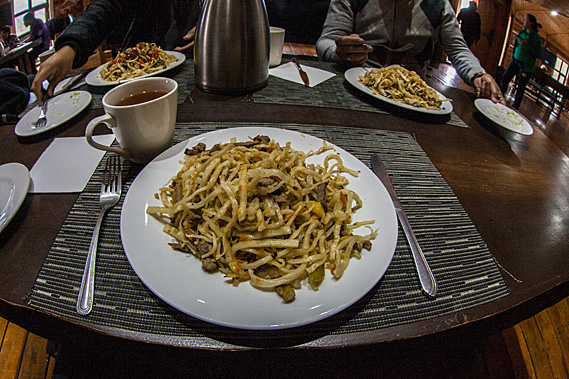 |
Dinner! |
The bus load of people who arrived earlier, plus a few other independent travellers with their guides, occupied most of the other tables in the hall. One of the independent travellers had just arrived for a two night stay here. I had travelled with him by train from Beijing. He was on his way home from Beijing to London having spent the past four years based in China teaching English, and had decided to return home doing the entire trip by train. Here we both were taking a break from our respective epic train trips across Eurasia. After staying here in Outer Mongolia, we were both heading towards Irkusk, then onto Moscow, before taking different routes – he to London and me to St Petersburg. Unfortunately we were going to be travelling a day apart so we will not be seeing each other again after tonight.
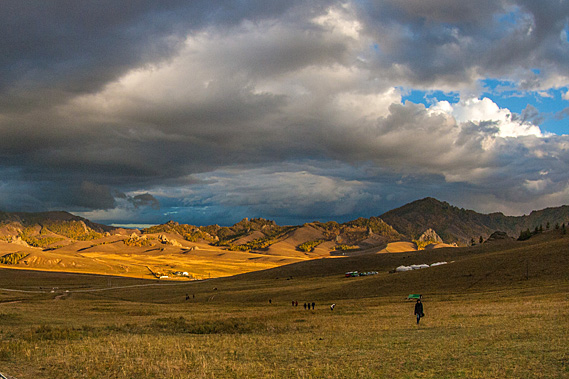 |
Late afternoon sunshine |
Following dinner I headed back towards the ger. The sun was very low now brilliantly illuminating the hills under the dark clouds. In particular the mountain with multiple tops like stunted fingers shone magnificently in the golden sunlight.
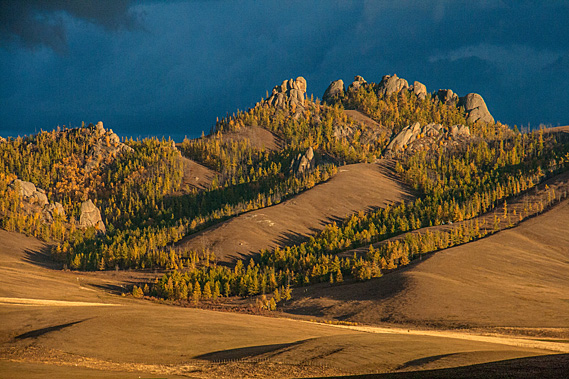 |
Mountain of stunted fingers |
The sun highlighted the deciduous trees from the pine trees rolling up its valleys to the exposed granite outcrops on top. The deciduous trees were going to sleep to hibernate through the long winter. The pine trees were going to stay awake all winter to tend over the sleeping deciduous trees. The clouds behind the mountain almost appeared black thanks to the angle of the sun.
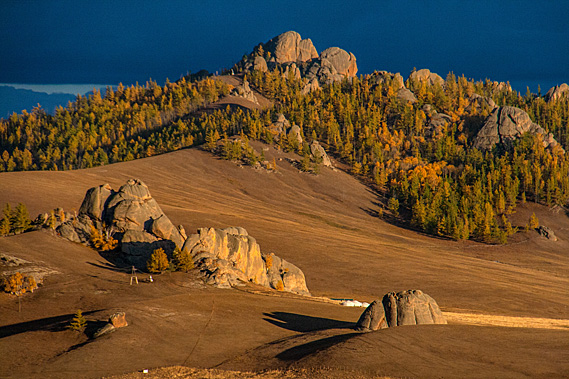 |
Golden hills and dark stormy sky |
There was little sign of life apart from the odd person in our camp staggering back to their ger with stomachs full from the enormous dinner. A small group headed up the hill to view the sunset. I knew though the best sunset views would be from down here.
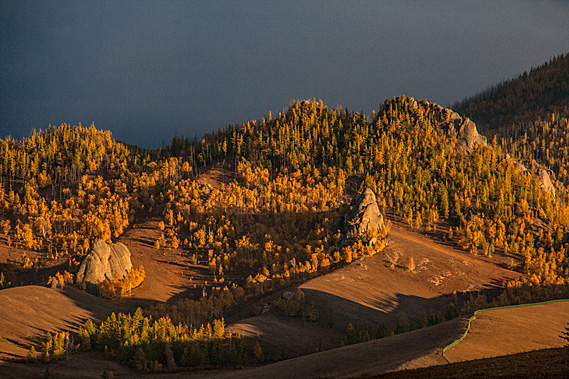 |
Highlighting the forests |
The shadow of the disappearing afternoon began to sweep across the valley. It had already dropped behind the cliff above the camp giving the air quite a chill to it. A glorious sunset was about to occur, the ending of just another day for the people who have lived here for many generations.
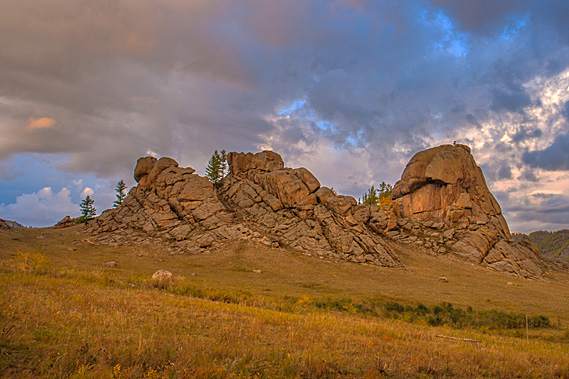 |
Spectacular colours |
The isolated groups of nomadic peoples here first came under rule in around the end of the third century BC. The Xiongnu Empire established itself in Central Asia. The first king Modun Changyu established the kingdom going from China’s Great Wall to the south, up to Lake Baikal to the north, and eastwards to the Korean peninsula. After around a century they formed a treaty with the Han dynasty of China, opening an important trade route.
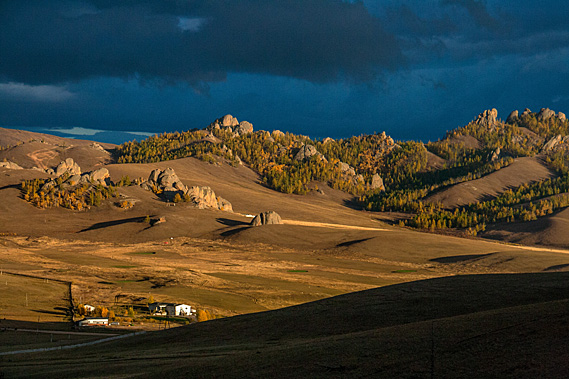 |
Shadow draws over the valley |
The Xiongnu empire declined until it was almost completely gone by the end of the 1st century AD.
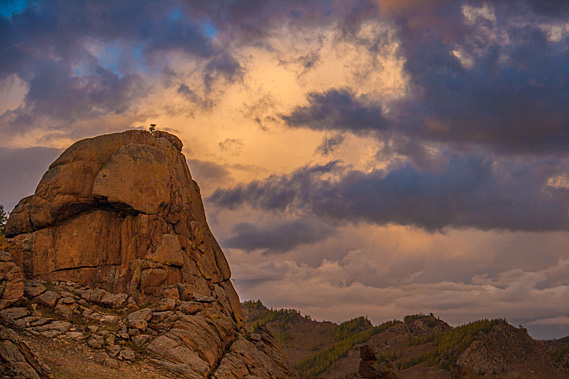 |
Dramatic clouds |
The brilliance of the yellows and oranges of the setting sun intensified as the shadows continued to draw across the valley.
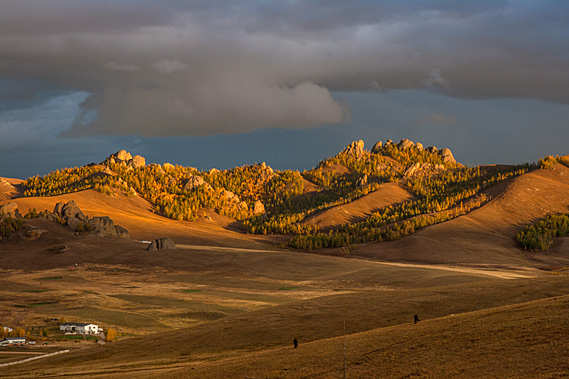 |
Shadow crossing the valley |
The highest hills on this side of the valley were now silhouettes against the sun. The clouds silently drifted across the sky with only the comet-like vapour trail of a plane, perhaps flying from Beijing to Irkutsk.
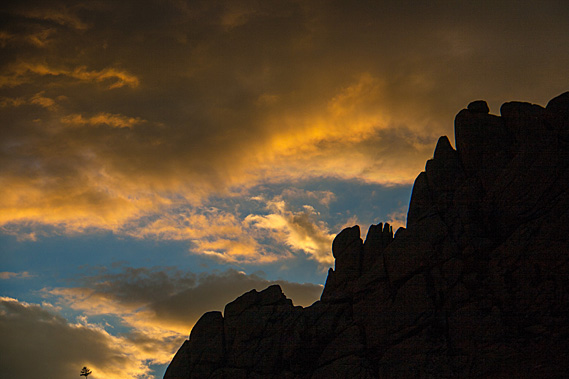 |
Jagged silhouette |
The sweeping shadow suddenly sped up, until sunlight was only showing on the exposed granite outcrops at the summits of the mountains across the other side of the valley.
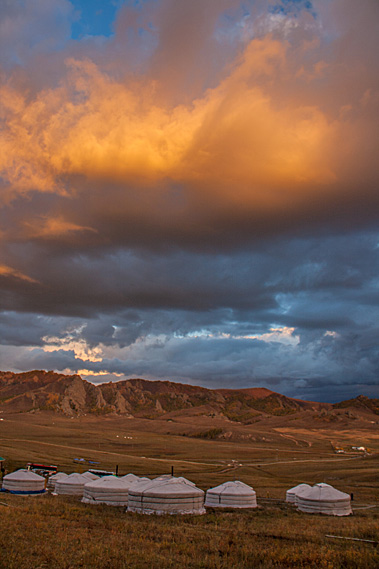 |
Fiery sky |
All the outcrops on this side of the valley became silhouettes, with the strange shaped outcrops and perfectly shaped pine trees creating a distinct outline against the dramatic textures and shapes of the clouds.
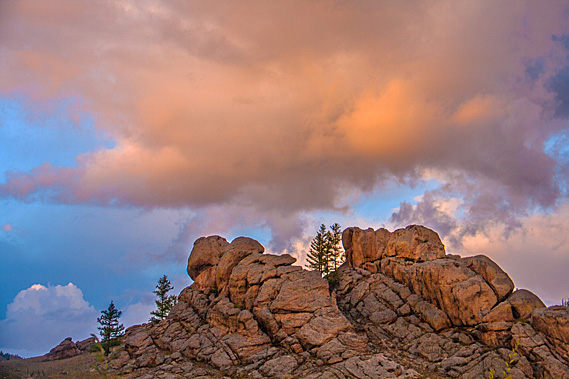 |
Dramatic land and skyscape |
The colours of the sunset quickly subdued. The horses continued grazing in the paddocks below the camp. The clouds overhead gave off one last fiery burst before the sun silently sunk beneath the horizon unseen behind the hills to cross over the other lands to the distant west once part of the Mongolian Empire.
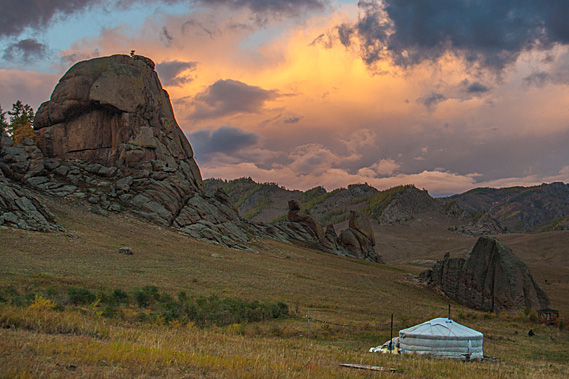 |
Brilliant storm clouds |
About four hundred years had passed following the demise of the Xiongnu empire when descendants of the original rulers formed the Hun Empire, under their leader Attila the Hun. This empire grew enormously taking over five states of China and once more extending westward towards Europe.
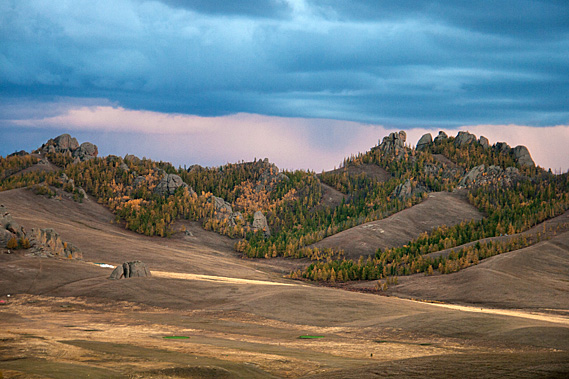 |
After sunset |
The Mongolian Empire reached its peak in the 13th to 14th century, growing even bigger than all previous empires. At its peak it extended northwards covering all the lands from Siberia and southwards into what is now South East Asia. It stretched from the Korean Peninsula all the way across to present day Bulgaria. The empire covered Tibet, who’s inhabitants introduced Buddhism throughout the empire. It took such a strong hold, it remains a dominant belief system throughout southern and eastern Asia. Although some of the eastern Asia religions are different now, they still have a strong basis in Buddhism.
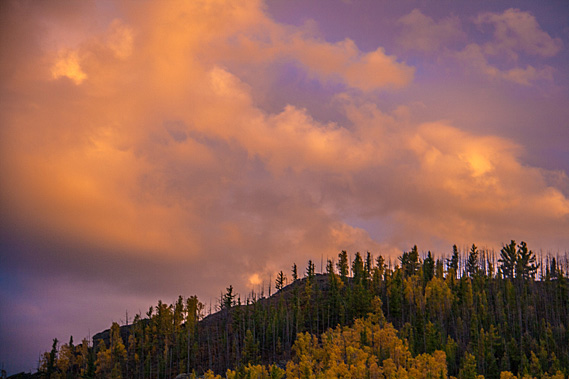 |
Final light in clouds |
The kingdom weakened to the west, with Buddhism quickly losing its influence in favour of Christianity spreading across the European continent. The empire remained strong in the east, but became threatened by the neighbouring Manchu empire occupying Manchuria, the part of China north of Beijing. The Manchu Empire grew in power until they were strong enough to cross the Great Wall of China in 1644 and conquer the Ming dynasty, replacing it with their own empire which they named the Qing dynasty.
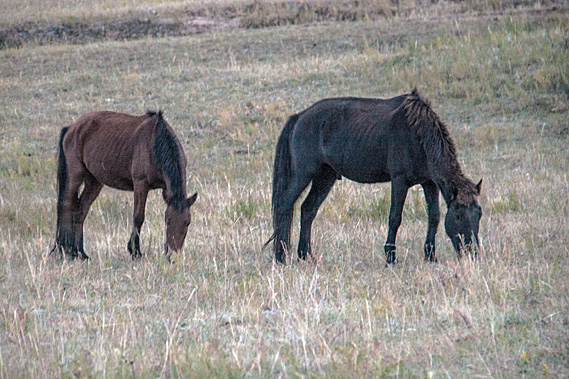 |
Horses still grazing |
At the same time the Mongolian empire was going through a difficult time with different factions of the Mongolian aristocracy fighting over the Mongolian throne. The Manchus were aware of this and decided to exploit it. This resulted in what was left of Mongolia being split into three areas. The first was Outer Mongolia which covered what is currently Mongolia. The second area was Inner Mongolia, to the south of the Gobi Desert, and Western Mongolia covering what is now Kazakhstan and parts of Russia and China. Outer Mongolia lost its independence falling to the Manchus in the latter half of the seventeenth century.
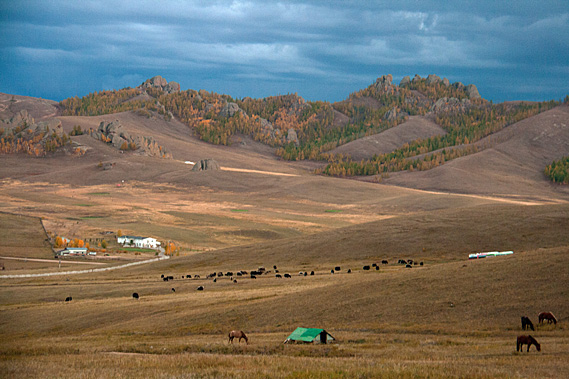 |
Valley after sunset |
I returned to my ger. One of the young fellows arrived and lit the fire again with more of the kindling in the tin box. He left just as the ger began to warm. Within a couple of minutes it had heated to almost sauna temperatures. I think one living here would need to feed the fire one piece of wood at a time to moderate the temperature.
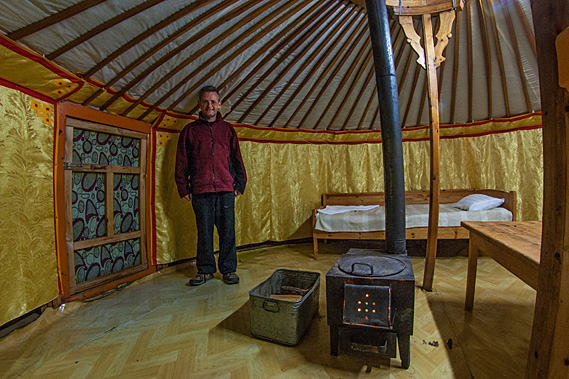 |
Inside the ger |
The temperature inside the ger continued to rise as the sky gradually darkened outside. The inside of the ger was brightly illuminated with The fire continued burning as I started charging some batteries ready for tomorrow.
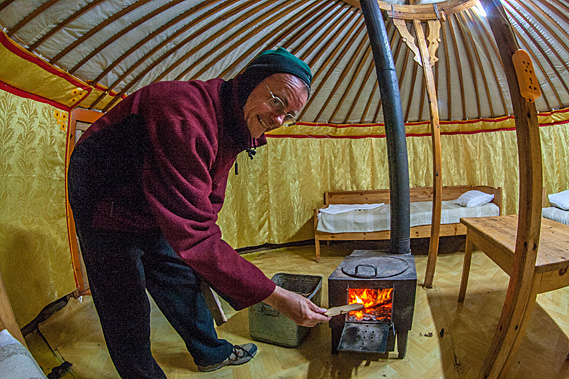 |
Stoking the hot fire |
I set up the camera onto the tripod and took it outside. The air was getting very cold, but not below freezing. The ger camp was illuminated with gentle lights just above the ground, enough to easily see around.
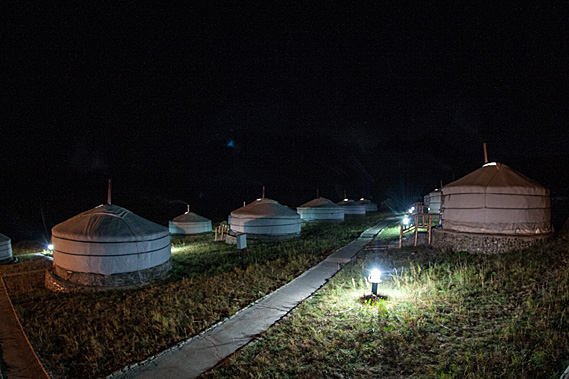 |
Ger camp at night |
Wearing my head torch, I headed up the hill about a hundred metres part way to the outcrops. I set up the camera looking around the sky. Almost all the cloud had cleared by now, revealing the bright stars. Some cloud still lingered above the mountaintops over the other side of the valley. Their ghostly grey forms were illuminated by the half gibbous moon soon to rise over the ridge to dramatically lighten the sky. I needed to capture the stars now before the moonlight floods the sky.
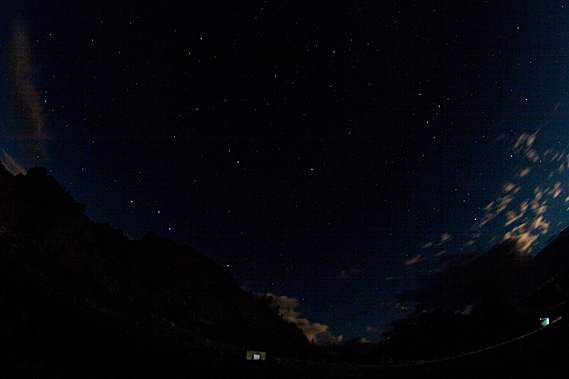 |
Sky as the moon rises |
Behind me was the pole star, which I had first spotted two weeks ago in the darkness of the beach at Mabon Resort in North Korea. I had not experienced a clear night outside since with either staying in polluted cities or travelling by train ever since. Here the sky was crystal clear with the pole star standing clear in its perpetually static location in the sky, Cassiopeia and the great dipper were just distinguishable coming out from behind the outcrops.
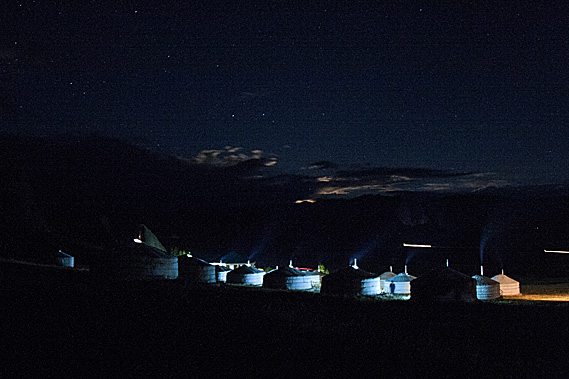 |
Moonrise beyond the camp |
The pole star was very easy to find, and it pointed directly north to within a tiny fraction of a degree. It was a lot easier to find than the south from the southern hemisphere. People in the northern hemisphere are very familiar with the pole star, but it is not visible from the southern hemisphere.
I recalled over the years meeting people from the northern hemisphere who were down under for the first time. If we met during a clear night, I would show them how to find south. It wasn’t as easy as finding the pole star. You would have to go between the pointers and the southern cross, then extend across to an imaginary empty point in space half way between this point and the star Archenar.
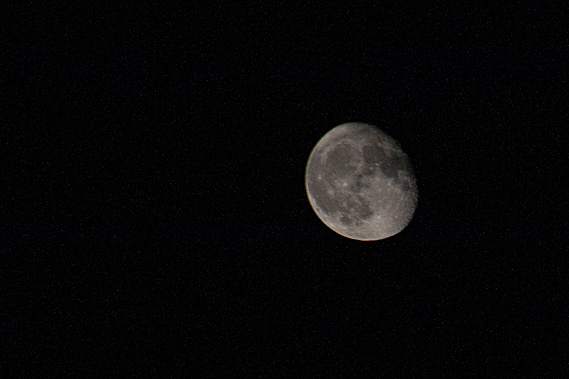 |
The moon |
None of those Southern Hemisphere stars I was familiar with were visible from here in the northern hemisphere at any time of year, so this sky was very unfamiliar to me.
I stayed out for a while photographing the stars and the campsite just in time before the moon rose above the mountains on the other side of the valley.
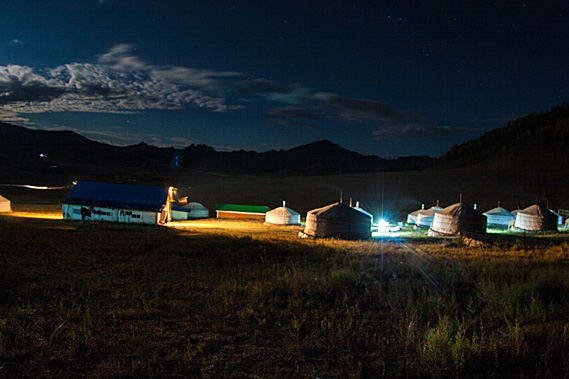 |
Camp under moonlight |
With the air quickly cooling to near freezing temperatures, I returned to the ger. The fire had by now died down and although still hot, the inside of the ger wasn’t a dry sauna anymore. It was comfortable enough now to crawl into bed and fall asleep.
|
